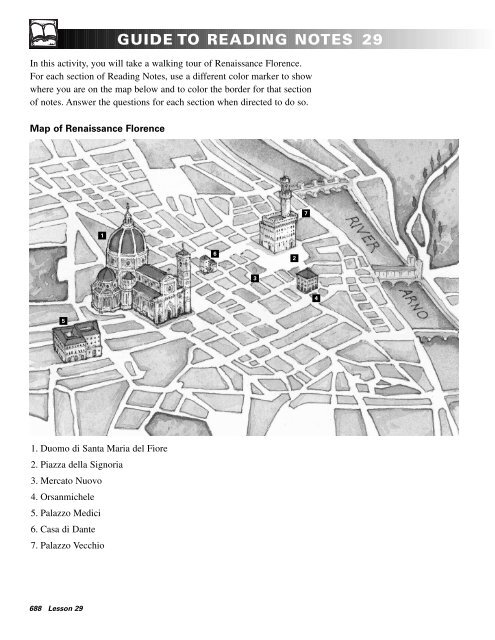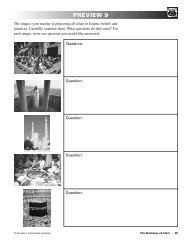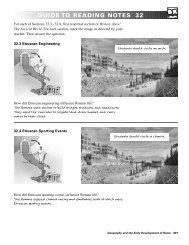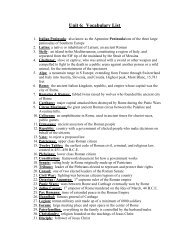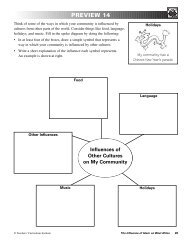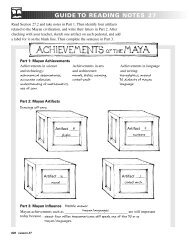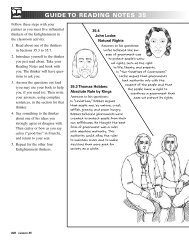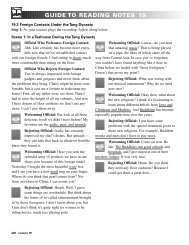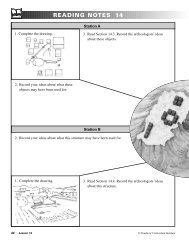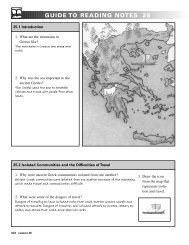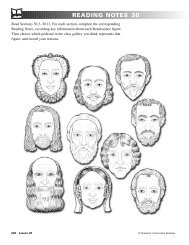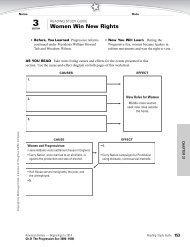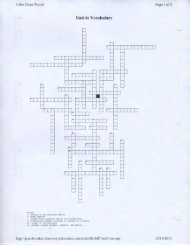GUIDE TO READING NOTES 29
GUIDE TO READING NOTES 29
GUIDE TO READING NOTES 29
Create successful ePaper yourself
Turn your PDF publications into a flip-book with our unique Google optimized e-Paper software.
<strong>GUIDE</strong> <strong>TO</strong> <strong>READING</strong> <strong>NOTES</strong> <strong>29</strong><br />
In this activity, you will take a walking tour of Renaissance Florence.<br />
For each section of Reading Notes, use a different color marker to show<br />
where you are on the map below and to color the border for that section<br />
of notes. Answer the questions for each section when directed to do so.<br />
Map of Renaissance Florence<br />
7<br />
1<br />
6<br />
2<br />
3<br />
4<br />
5<br />
1. Duomo di Santa Maria del Fiore<br />
2. Piazza della Signoria<br />
3. Mercato Nuovo<br />
4. Orsanmichele<br />
5. Palazzo Medici<br />
6. Casa di Dante<br />
7. Palazzo Vecchio<br />
688 Lesson <strong>29</strong>
<strong>GUIDE</strong> <strong>TO</strong> <strong>READING</strong> <strong>NOTES</strong> <strong>29</strong><br />
<strong>29</strong>.3 Advances in Architecture and Engineering: Duomo di Santa Maria del Fiore<br />
1. Briefly describe two ways that classical ideas influenced Renaissance architecture.<br />
Renaissance buildings were modeled on ancient ruins. They had Greek- and Roman-inspired<br />
features such as arches, columns, and domed roofs.<br />
2. How did Brunelleschi build a dome that wouldn’t collapse?<br />
He used eight stone arches that leaned against each other. The arches were supported by<br />
hoops of iron, wood, and brick.<br />
3. Compare your human dome to Brunelleschi’s dome by completing the sentences.<br />
• On our dome, the parts of our bodies that supported the most weight were<br />
our legs and feet.<br />
• On Brunelleschi’s dome, the parts that supported the most weight were<br />
the arches.<br />
• The feet on our dome were like the bottom of the arches, or the base, on Brunelleschi’s dome.<br />
• The beach ball on our dome was like the lantern on Brunelleschi’s dome.<br />
• The bodies on our dome were like the arches on Brunelleschi’s dome.<br />
Our dome<br />
Brunelleschi’s dome<br />
Florence: The Cradle of the Renaissance 689
<strong>GUIDE</strong> <strong>TO</strong> <strong>READING</strong> <strong>NOTES</strong> <strong>29</strong><br />
<strong>29</strong>.4 Advances in Painting: Palazzo Medici<br />
1. Briefly describe two Renaissance advances in painting styles.<br />
Renaissance figures were more realistic, with lifelike poses and emotions. Renaissance art used<br />
more realistic backgrounds, giving a sense of depth, or space.<br />
2. Briefly describe two Renaissance advances in painting techniques.<br />
Possible answers: Renaissance painters used geometry to divide space, perspective to make scenes<br />
look more realistic, and oil paint to redo work and show new details and textures.<br />
3. Botticelli<br />
painted<br />
Adoration<br />
of the Magi<br />
in about 1482.<br />
On the image,<br />
label at least<br />
three perspective<br />
techniques he used.<br />
The columns look flat<br />
when you look<br />
straight at them,<br />
but seen from<br />
another angle<br />
they have width.<br />
Closer figures<br />
seem bigger, those<br />
farther away<br />
seem smaller.<br />
The mountains<br />
are pale blue<br />
and blurry to<br />
show they are<br />
in the distance.<br />
The viewer’s<br />
eyes are drawn<br />
toward Mary<br />
and Jesus.<br />
<strong>29</strong>.5 Advances in Sculpture: Piazza della Signoria<br />
1. Briefly describe two ways in which Renaissance sculpture was different from medieval sculpture.<br />
Renaissance sculptures were three-dimensional, freestanding, looked like real people, and<br />
showed emotions.<br />
2. What was so amazing about Donatello’s David? About Michelangelo’s David?<br />
Donatello’s “David” was a life-size nude that showed personality and mood and was very natural<br />
and lifelike. Michelangelo’s “David” was enormous, beautiful, and showed complex emotions.<br />
3. What was it like to try to sculpt an eye from a cube of clay? What do you think it might have been<br />
like for Michelangelo to create his David from a block of marble?<br />
Answers will vary.<br />
690 Lesson <strong>29</strong>
<strong>GUIDE</strong> <strong>TO</strong> <strong>READING</strong> <strong>NOTES</strong> <strong>29</strong><br />
<strong>29</strong>.6 Advances in Literature: Casa di Dante<br />
1. Briefly describe two ways in which Renaissance literature differed from medieval literature.<br />
Medieval literature was usually about religious subjects and was written in Latin and in an<br />
impersonal style. Renaissance literature included works about nonreligious subjects and was<br />
written in local dialects and in a more personal style.<br />
2. How is Dante’s The Divine Comedy an example of humanist art?<br />
Dante’s work expressed strong emotions, was about the experience of individuals, and commented<br />
on society and people of the time.<br />
3. Write the place from Dante’s imaginary journey—Paradiso, Purgatorio, or Inferno—that each<br />
image depicts.<br />
Purgatorio Paradiso Inferno<br />
4. Read the following passage from Dante’s The Divine Comedy. Then complete the sentence.<br />
Italian<br />
Quivi sospiri, pianti e alti guai<br />
risonavan per l’aere sanza stelle<br />
per ch’io al cominciar ne lagrimai.<br />
English<br />
Here sighs and lamentations and loud cries<br />
were echoing across the starless air<br />
so that as soon as I set out, I wept.<br />
I think this passage describes ________________________ Inferno<br />
because…<br />
(Paradiso, Purgatorio, Inferno)<br />
it’s dark and there are sighs and cries and sadness.<br />
Florence: The Cradle of the Renaissance 691
<strong>GUIDE</strong> <strong>TO</strong> <strong>READING</strong> <strong>NOTES</strong> <strong>29</strong><br />
<strong>29</strong>.7 Advances in Science and Mathematics: Orsanmichele<br />
1. How did the study of science change during the Renaissance?<br />
During the Renaissance, people used a new approach: they questioned old ideas, made careful<br />
observations, performed experiments, and analyzed the results.<br />
2. List four science or mathematics topics Leonardo explored in his notebooks.<br />
Leonardo explored geometry, engineering, anatomy, motion, sound, architecture, and more.<br />
3. These drawings are from Leonardo’s notebooks. Write what you think each drawing represents.<br />
device for raising water<br />
flying machine<br />
four-wheeled armored tank<br />
proportions of a<br />
man’s head<br />
a building<br />
physics and geometry<br />
calculations<br />
map of a city<br />
692 Lesson <strong>29</strong>
<strong>GUIDE</strong> <strong>TO</strong> <strong>READING</strong> <strong>NOTES</strong> <strong>29</strong><br />
<strong>29</strong>.8 Florentine Politics: Palazzo Vecchio<br />
1. How did the Medici family rule Florence for so long?<br />
The Medicis were involved in many aspects of city life. They kept a strong military, built<br />
palaces, sponsored art, and defeated their enemies.<br />
2. What was Machiavelli’s book The Prince about?<br />
His book is a realistic description of politics, government, and how rulers can make their<br />
states strong.<br />
3. Rewrite each quotation in your own words as if explaining to another student what<br />
Machiavelli meant. Then indicate whether you agree or disagree with his statement.<br />
Quotation 1 A prince should have no other aim or thought, nor take up any other<br />
thing for his study, but war and its organization and discipline, for that is the only<br />
art that is necessary to one who commands.<br />
My interpretation:<br />
Possible answer: A political leader should master the art of war above all else.<br />
I agree / disagree with Machiavelli.<br />
Quotation 2 Thus, it is well to seem merciful, faithful, humane, sincere, religious,<br />
and also to be so; but you must have the mind so disposed that when it is merciful<br />
to be otherwise you may be able to change to the opposite qualities.<br />
My interpretation:<br />
Possible answer: Look like you have good and admirable qualities, but be willing to display<br />
the opposite qualities when necessary.<br />
I agree / disagree with Machiavelli.<br />
Quotation 3 In the actions of men, and especially of princes, from which there is<br />
no appeal, the end justifies the means.<br />
My interpretation:<br />
Possible answer: The actions we take are considered acceptable or unacceptable based<br />
on the results we want to achieve.<br />
I agree / disagree with Machiavelli.<br />
Florence: The Cradle of the Renaissance 693
<strong>GUIDE</strong> <strong>TO</strong> <strong>READING</strong> <strong>NOTES</strong> <strong>29</strong><br />
<strong>29</strong>.9 Florentine Commerce and Trade: Mercato Nuovo<br />
1. What industries helped Florence become the center of the Renaissance?<br />
The woolen-cloth and banking industries helped Florence become the center of the Renaissance.<br />
2. What were two differences between Florence’s Old Market and New Market?<br />
The Old Market was crowded and smelly and was where everyday items such as food and<br />
household goods were sold. The New Market was orderly and clean and was where cloth was<br />
sold and banking was done.<br />
3. List the item(s) you purchased with your florins. Then complete the sentence.<br />
Answers will vary.<br />
I bought these things with my florins:<br />
I bought these things because…<br />
694 Lesson <strong>29</strong>


